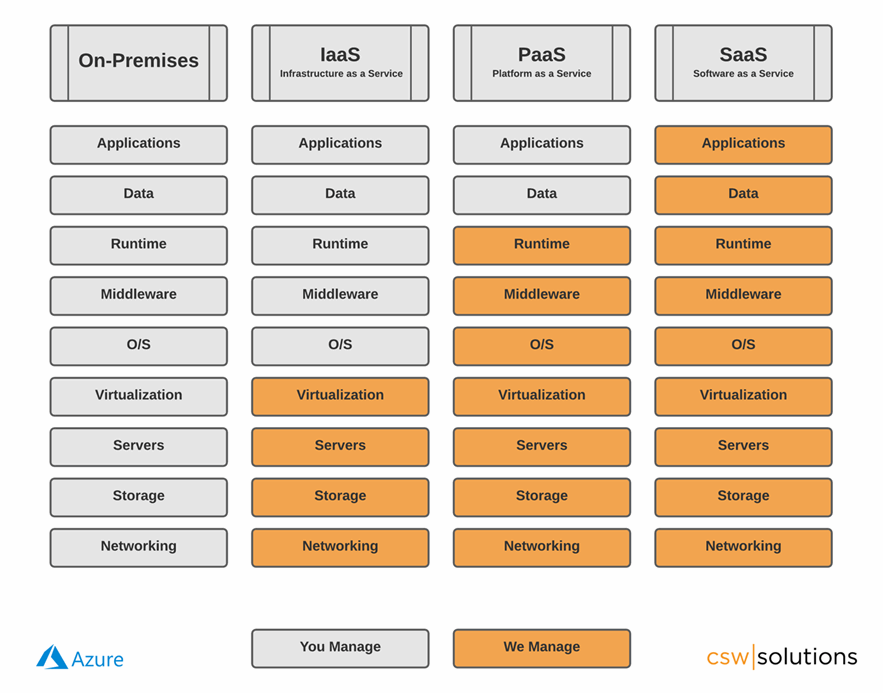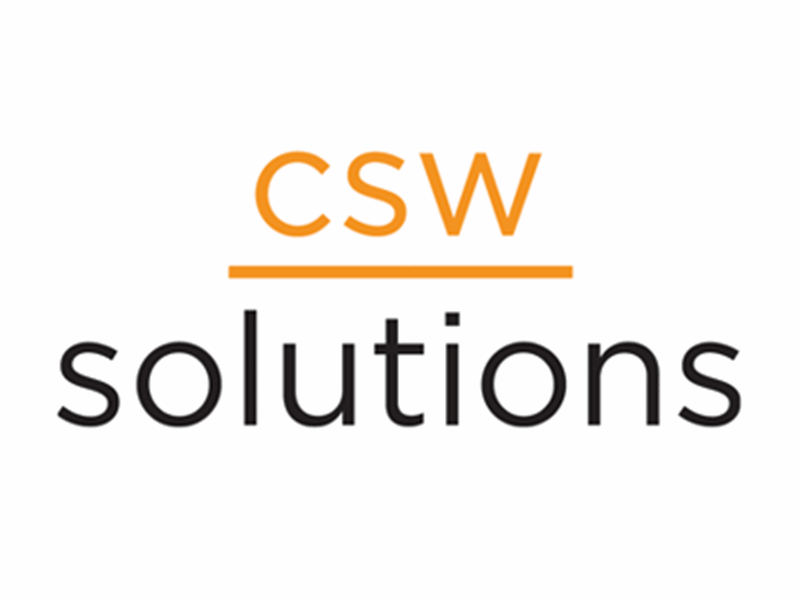For more information on your charming neighborhood CSW Solutions, visit us at our home or subscribe to our newsletter! We also do that social networking thing at: Twitter, Facebook, Linkedin, and Instagram! Check out our #funfactfridays
What is Azure?
The age of cloud is upon us. The cloud has been undeniably reliable throughout the pandemic with proven scalability and optimization. Most companies have spent the better part of the year trying to figure out how to pivot, adapt, and do their best to keep employees confident and productive at home with business continuity as a key factor. To thrive in a fragile market, we need systems and processes that can be adjusted and updated to provide products and services with maximized capabilities. So, prioritizing what comes next is essential. Microsoft has been a longstanding leader in computing but for some of us, trying to understand the versatility of Microsoft Azure can be a daunting if not convoluted process! Microsoft Teams, along with Microsoft 365 and Virtual Desktop are only part of the foundation to an optimum suite of tools for all your business needs, especially now.
Azure is essentially the substructure of the Microsoft cloud. It is an integrated suite of multifaceted tools and services to provide security, reliability, and productivity to cloud management. It is technically a cloud computing platform where you can build, test, deploy, and manage applications and infrastructure through Microsoft’s vast and ever-growing data capacity. Azure also supports nearly all OS, languages, frameworks, tools, databases, and devices. You can access and store information from anywhere using three main types of solutions. Those solutions are Software as a Service (SaaS), Platform as a Service (PaaS), and Infrastructure as a Service (IaaS).
Let's explore these solutions a little more in how they work within Azure:
SaaS is a licensing delivery model where software is licensed on a subscription basis through a central host. The provider manages access to the application along with security, performance, and scope. This is the best choice for a business that needs a scalable, updated replacement for traditional software with low overhead. In Azure, these are cloud-based programs available in Microsoft 365, such as Microsoft Office tools, email, calendaring, etc.
PaaS is where a computing platform is provided for the customer to be able to develop, run, and manage apps without the hassle of building or maintaining the infrastructure. This typically includes the OS, language and environment, database, and web server, etc. Azure has two main components; the application files such as the source code, DLL, etc. and the configuration file. These two manage a combination of Worker Roles and Web Roles. Azure handles all the hard work of the operating systems on your behalf, so you can focus solely on a quality application for the end-users.
The Web Role is a preconfigured Azure VM as a server that automatically loads the developed application when the VM boots up. This results in the public endpoint for the application which is usually in the form of a website but could be an API or similar.
IaaS is one of Azure's main features as a virtual data center. That is where virtualized computing resources such as servers, storage, and networking are provided remotely. Organizations use their own platforms and applications within the infrastructure but have full control over scaling and changes as needed.
These three solutions make up the purview of cloud computing and in Azure each one offers a unique process in accessing the building, running, and management of applications across multiple clouds with the tools and frameworks you've chosen. Here's the visual breakdown:

Data-driven Metrics
In an era when everyone is fighting for a spot in the growing number of choices online, the supply chain bottleneck can be frustrating. What if there was a way to be able to predict the behavior of a customer and tune into their need-state and direct them to your business or products? By identifying the flow of customers between brands and structuring a platform for you, Azure can give you the tools to do just that. By maximizing supply chains through safe cost reductions and optimizing operations based on data, you can gain access to new audiences and discover untapped growth. There are numerous AI services and Machine learning tools in Azure that can provide you with the operational algorithms to meet unique challenges and evaluate production data. Everything from QA analysis, operational reports, equipment effectiveness, and packaging or retail distribution analyses can keep you informed and efficient from top to bottom without expending the time and resources of on-site management or in-person teams. That's just one aspect of the many ways you can use Azure managed services to overcome obstacles that seem overwhelming in a time of unprecedented interruption in business and remote security.
What about Security?
That's easy. Azure has multilayered security across decentralized datacenters, enterprise-grade cloud infrastructure, and operations. It is the first platform to deliver confidential computing which encrypts your data while in use. Your business is protected with industry-leading physical security systems and a comprehensive portfolio of compliance offerings and privacy standards. For example, running data through redundant sites during recovery periods offers an efficient, flexible alternative. These periods can last from a few minutes to a few hours instead of those long days where you're just staring at your IT team with your fingers crossed! On top of the redundant power, there is networking and cooling, as well as software elements like safe deployment processes, impact-less maintenance, and failure prediction enabled by machine learning. The adjustment of processes and controls to combat security issues or updated protocols can be done faster and more efficiently. As Microsoft CTO, Mark Russinovich said,
"Today customers in finance, government, healthcare, and telecom use Azure to detect fraud, improve communications privacy, secure blockchain, deliver multi-party machine learning, and enable secure key management."
At your fingertips are also the basic necessary tools for error logging and monitoring, diagnostics, and troubleshooting to ensure continuous service delivery in your cloud environment. You can get insight into the performance of your confidential cloud network and take preventative measures to ensure that bottlenecks, service failures, or slowdowns are resolved without disruption. Recorded crash dump data can provide insight and since these can be recorded with Azure, you can prioritize troubleshooting to strategize so nothing disrupts your operations. Azure can also be used to view traffic patterns or log-in anomalies, ensuring another level of security to your network. Custom error logs are another way to inform you about defined error events. This means that you can add specific error types to your heal checklist for Azure to maintain. Now talk about exclusivity!
The further in you go, the bigger it gets.
Not only is Azure available in 140 countries with resources split across 160+ worldwide scalable datacenters, it is linked by one of the largest interconnected networks in the world. It offers over 600 products and cloud services that can be tailored to be as flexible and useful as you need them to be. It only makes sense that 96% of Fortune 500 companies are already using Azure. That not only means it is a proven success but that it is capable of handling an enterprise of any size.
At its core, Azure is a cloud computing platform from Microsoft that can be used for services such as analytics, virtual computing, storage, networking, and much more. Azure continues to expand in capabilities and serviceability and that could be a deciding factor for anyone who might be on the fence about the cloud. All the elements necessary to build a virtual network so you can deliver services or provide an application to a global audience are available and you can't beat the scalable cost. It is the best way to get practical yet extensive visibility into your aggregated logs and infrastructure metrics so your team can react quickly to opportunities and be prepared for whatever else 2020 wants to throw at you! But wait, there's more!
Sustainability
Microsoft has been carbon neutral since 2012 and on track to be carbon negative by 2030. Not only are you investing in the most reliable cloud service platform out there but you're joining the growing community of industry leaders that are reducing energy use and transitioning to a more carbon-neutral grid with Azure. Recently, Microsoft published a study on the carbon benefits of cloud computing. The results are clear that Azure is as much as 98% more carbon efficient than on-premises solutions. The power of partnering with Microsoft, whether through a cloud service provider or hybrid cloud solution will not only empower you and your business to work sustainably but rest assured that you have a role in building a future for the planet.
Partnership
Even with Azure’s native logging and analytics tools, all that quantitative data flowing in to make your network and applications operate can be overwhelming. The flow of capital and liquidity are critical to organizations for survival and someone's gotta be looking out for you. There is no better platform than Microsoft Azure to remain vigilant as we are now in a period of adjustment and prioritizing for what comes next. Cloud computing must not be underestimated as it can be adaptable, unrelenting, and vast. But with the help of CSW Solutions, a Gold-certified Microsoft partner, management of that data and its environment can be simple. Contact us today to see what Azure can do for you.
